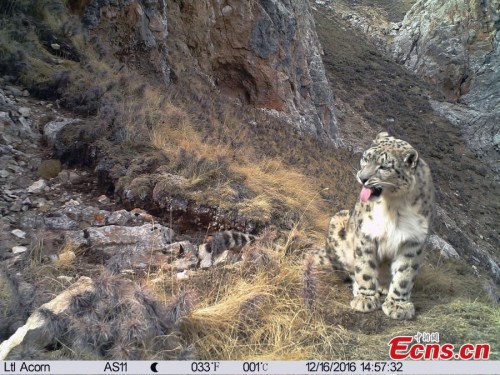
A picture taken by an infrared camera shows a snow leopard in the Lancang River catchment in Yushu Tibetan Autonomous Prefecture, Northwest China's Qinghai Province. Xiao Lingyun of the Shanshui Conservation Center said the discovery of animals including snow leopards, leopards, brown bears, wolves and jackals shows the area has one of China's most diverse populations of large and medium-sized predators.(Photo provided to China News Service)
Wildlife protectionists and herders said diversity of wild animals has increased in the Sanjiangyuan area, China's first planned national park.
A three-year observation project, which began in 2014, found frequent appearances by snow leopards, brown bears, lynxes, Tibetan foxes, wolves, steppe cats and otters in the region, said Dr. Xiao Lingyun with Peking University Center for Nature and Society.
These animals were observed in a 2,000-square-kilometer area, Xiao said.
"From images captured by infrared cameras, these animals often move around, not alone but in groups, and their way of moving shows they have a rather casual lifestyle," she said.
It is generally known that wild animal habitats have grown increasingly fragmented under human threat, but the fact that wild carnivores were frequently observed at the source of the Lancang River is a key sign that the area has a diverse animal population, Xiao said.
"Some wild species establish their habitats near residences of local herders, and they are not fearful toward humans," said Zhao Xiang, a wildlife protectionist with Shanshui Nature Protection Center, a Beijing-based organization.
Sanjiangyuan literally means "the source of three rivers," referring to the Yangtze, Yellow, and Lancang (Mekong) rivers.
Planning began on a national park in the area last year, aiming to protect the headwaters of the three rivers. It is expected to officially open in 2020.


















































